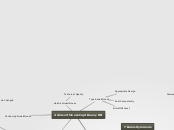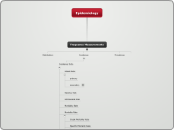Pulmonary Embolism
Complications
DEATH
Recurrent PE
Bleeding (when on anti-coagulants)
Pleural Effusion
Organ injury: pulmonary infarction
L. heart failure
R. heart failure
Diagnostics
Wells Criteria
Malignancy +1
Hemoptysis: +1
Surgery/Immbolization w/in 1 month: +1.5
Tachycardia +1.5
Previous DVT/PE +1.5
Clinical Sxs of DVT: +3
PE is more likely than other diagnosis: +3
EKG
non specific ST and T- wave abnormalities
Tachycardia, pseudo RBBB, S1Q3T3
Imaging
(Spiral) CT /
Pulmonary Angiography
Wedge-Shaped Infarct
Decreased Vascular Filling
(Compression)
Ultrasound w/ Doppler
Used to find thrombi
X-Ray
Clear
1. Hamtpon's Sign
2. Fleishner's Sign
3. Westermark Sign
Labs
Other
WBC
Leukocytosis
Arterial Blood Gas
High pH, low PaCO2, low PaO2,
increased A-a, normal -> decrease
D-Dimer
Increases after surgery
Highly sensitive (snout)
Pregnancy: >500 for ~ 30 days until
decrease.
Treatment/Management
Management
Lifestyle Changes: exercise, stop smoking,
mobility,
Vitals: Vasopressors
Compression Socks
Anticoagulants
Non-Pregnancy
Thromboectomy
IVC Filter if anticoagulants are contraindicated
3 Month minimum of warfarin
LMWH, factor Xa inhibitor,
tPA (hemodynamically unstable),
Pregnancy/Breast Feeding
tPA
SubQ LMWH
IVC filter if anticoagulants
are contraindicated
Clinical Presentation
Sxs
SOB, Pleuritic Chest Pain,
Hemoptysis, Tachypnea,
Tachycardia, Hypotension,
Fever, Decreased Breath Sounds,
Loud P2 (S2), Unilateral swelling,
erythema, pain with dorsiflexion (Hooman's),
Meyer's sign, syncope (w/ saddle emboli),
Asx
Differentials
Post Surgical
Complications
MSK
MI
Congenital Defects/
Underlying Disorders
R Sided Heart Failure
Pulmonary Hypertension
Risk Factors
Previous DVT/PE
Previous Surgeries
Hypercoaguability Disorders
Immobility
Malignancy
Smoking
Long Bone Fracture
Pregnancy/OCP
Virchow's
Types of
P.E.
DVT
Air
Divers/
Procedures
Amniotic
During Deliver/
Shortly After
Fat
Long Bone fx/
Liposuction/
Brazilian Butt Lift(BBL)
Pathophysiology
Decreased CO: hypotension, tachycardia, vasoconstriction
Increased PVR --> increased RV pressure -->
dilation + hypertrophy
V/Q mismatch: increased dead space (V/Q>1),
increased TV, RR, O2 sat, A-a gradient, HR,
respiratory alkalosis
Embolus dislodges from clot due to HTN,
Pregnancy --> high estrogen levels
create hypercoaguable state









